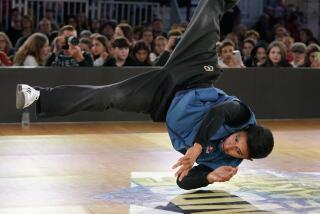Caught Up in the Ultimate Comeback Sport
- Share via
Like original sin or bad chili, Budd Jamieson’s favorite pastime keeps coming back on him.
And it’s a good thing.
If the homemade fiberglass-composite boomerang he calls the Pigeon were to keep traveling, it could take off someone’s head.
Jamieson, a computer expert in the materials engineering department at UC Santa Barbara, is a past U.S. champion of distance boomerang throwing.
In 2000, he threw the Pigeon 155 meters -- the equivalent of a football field plus 70 yards. More incredible, The Pigeon flew all the way back, whirring past Jamieson at a speed that would slash the palms of anyone foolhardy enough to try to catch it.
A well-thrown boomerang can travel faster than 60 mph. If you’re like Jamieson, you hold it almost vertically, more like a tomahawk than a Frisbee.
You rip up a few blades of grass and let them fall to gauge the wind. You take a few short, strong steps and let loose. But putting the secret of a successful launch into words is like trying to put mojo in a bottle.
Practicing on a massive athletic field at the university, Jamieson spoke with the enthusiasm of a boy scientist about spin, airfoils and thermal currents. But explaining how to actually throw the thing, he was more roundabout.
“It’s in the wrist, it’s how you snap your arm, it’s how much you want to put yourself in pain,” Jameson ventured. “It’s -- I don’t know.”
Whatever it is, it can be addictive when you finally get it.
“It’s just magical,” Alan Scott Craig said as he crafted high-end art boomerangs in the workshop at his Fillmore home. “It’s like a moving meditation or a ballet. You have to work with nature, with the wind, with the environment, with obstacles. You can’t think about anything else.”
For 15 years, Craig has made a living turning laminated birch into boomerangs shaped like parrots and toucans, eagles and gaudy tropical fish. From ingeniously arranged, oddly shaped boomerangs he fashions stylized scenes: a golf course here, a motorcycle racer there.
Several of his works are in a Smithsonian collection and others hang on the walls of Hollywood celebrities.
“People buy them as showpieces,” said Craig, who test-flies each piece before selling it. “It’s the only art you can buy with a guaranteed return.”
Just across town -- who would have guessed tiny Fillmore would have two boomerang makers? -- Steve Conaway makes what insiders call “ ‘rangs” for his Aboriginal Steve’s Internet business. Over 11 years, he figures he’s made more than 6,000, selling them to NASA as convention giveaways, to the “Survivor” TV show as props for contestants, and to throwers across the United States as sporting gear.
“We’re out there,” said Conaway, a power system operating specialist for Southern California Edison. “We’re a small group of whacks, but we’re out there.”
Boomerangs took off in this country with the help of Ben Ruhe, a former curator of aboriginal art at the Smithsonian. In the 1970s, Ruhe organized an annual fling in the shadow of the Washington Monument, introducing thousands to the ancient club of the outback.
When he was a boy in Ohio, Gregg Snouffer talked his parents into a trip to the event in 1978. Like a you-know-what, he came back the next year, and the next. Today, he’s president of the 300-member U.S. Boomerang Assn., a veteran of a boomerang tour for a British cereal called Uncle Toby’s Oats, and a frequent participant in international competition.
“There’s got to be thousands of people who are into it,” said Snouffer, a high school teacher and coach. “We keep running into closet boomerangers everywhere.”
In the U.S., there are about 20 tournaments yearly. The sport’s World Cup -- the current champions are a team from Germany -- is staged every two years. The field is mostly men: largely engineers, pilots, kite-fliers and others intrigued by the physics of what has been called “the thinking man’s Frisbee.”
“People into aerodynamics are working with all kinds of new materials,” Snouffer said. “It would really blow away guys from 20 years ago.”
Competitors throw for more than distance. There are trick-catch specialists who can trap a speeding ‘rang between their feet. Some throwers craft their boomerangs for maximum-time-aloft contests, with one achieving an astounding unofficial time of more than 17 minutes.
In the fast-throw event, the reigning champion is a Brooklyn, N.Y., teenager who threw and caught five consecutive 20-meter shots in 13.9 seconds.
Then there are throwers such as Gary Broadbent, an inspirational speaker from Canton, Ohio, with a collection of about 15,000 boomerangs. A man who talks as fast as he throws, Broadbent has won his share of records, but he especially savors sailing his favorite ‘rangs around world landmarks.
“I’ve boomed the St. Louis arch, the Eiffel Tower, the Washington Monument, Yosemite, the Grand Canyon and the Golden Gate Bridge,” Broadbent said from his boomerang shop in Canton. “I’ve boomed the cathedral in Cuneo, Italy. Everyone ran to the square and they were amazed!”
Once a salesman for Campbell’s soup, Broadbent said he quit his job for boomerangs, becoming a kind of evangelist for “the most complex flying machines on Earth.”
“They’re everything to me,” he said. “The greatest gift in my life came from the aborigines.”
For Jamieson in Santa Barbara, throwing is more a passion than an obsession. Like any devoted thrower, he makes his own, molding the material used in computer circuit boards into something that looks a lot like a question mark.
His distance title was snagged by his friend Erik Fields, an oceanographer at the university. Fields, who throws less these days because of a skydiving injury, bested him by just three meters.
“I told Erik: I’ve got to get it back,” Jamieson said as his practice session drew to a close.
And what sport would be better suited than boomeranging for the efforts of a comeback kid?
More to Read
Go beyond the scoreboard
Get the latest on L.A.'s teams in the daily Sports Report newsletter.
You may occasionally receive promotional content from the Los Angeles Times.











